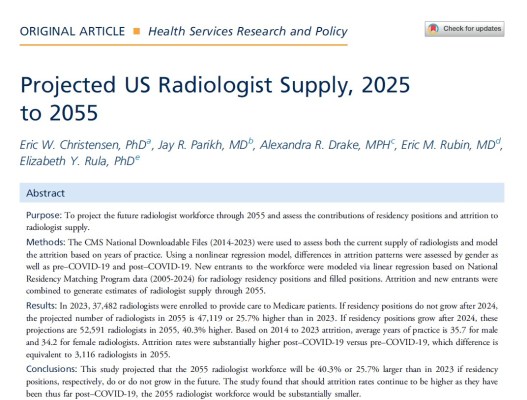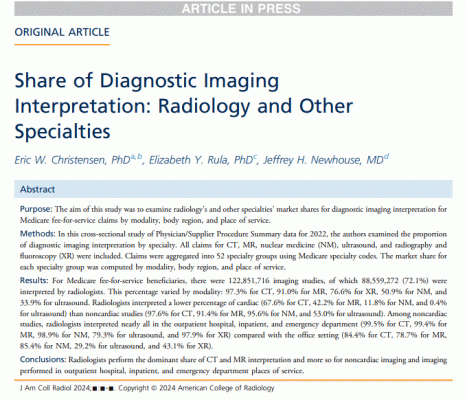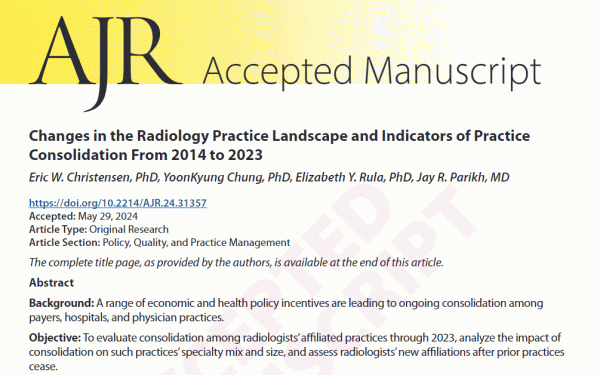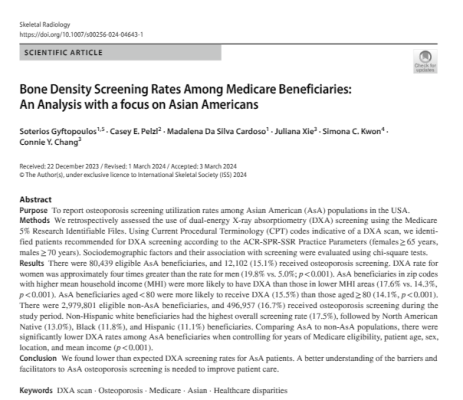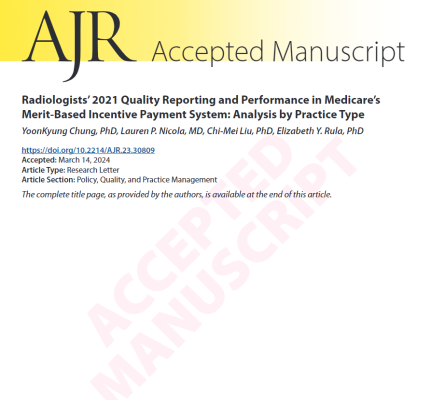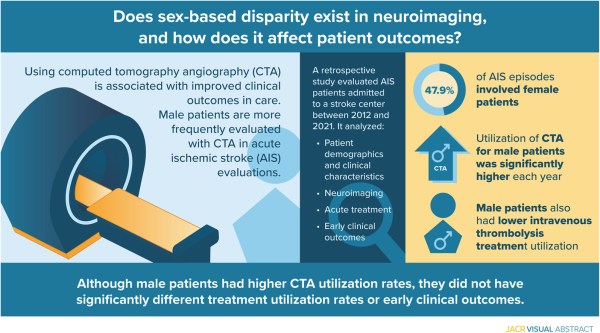June 5, 2025
Workloads and Staff Shortages: A Conversation with Dr. Elizabeth Rula This is the second of an 8-part series on radiologist well-being. The author is Emory University Center for Ethics professor John Banja, and the blog is supported by an unrestricted grant from the Advanced Radiology Services Foundation. Watch the interview with Dr. Elizabeth Rula, Executive Read More
The Merit-Based Incentive Payment System (MIPS) is the largest pay-for-performance program that links reimbursement to performance of Medicare clinicians. This study evaluated radiologist performance in the 2019 MIPS program and predictors of scores and underperformance. Full Article
YoonKyung Chung, PhD, Chi-Mei Liu, PhD, Lauren P. Nicola, MD, Elizabeth Y. Rula, PhD. 2025. "Factors Influencing Radiologist Performance in the Merit-Based Incentive Payment System," Journal of the American College of Radiology (JACR)
The purpose of this study is to project the future radiologist workforce through 2055 and assess the contributions of residency positions and attrition to radiologist supply. Full Article
Eric W. Christensen, PhD, Jay R. Parikh, MD, Alexandra R. Drake, MPH, Eric M. Rubin, MD, Elizabeth Y. Rula, PhD. 2025. "Projected US Radiologist Supply, 2025 to 2055," Journal of the American College of Radiology (JACR)

For high-risk women, breast magnetic resonance (MR) is the preferred supplemental imaging option, but spatial access differences may exacerbate disparities in breast care. The primary aim of this study was to examine the relative distance to breast imaging facilities with MR compared to facilities offering mammography or ultrasound. Access to advanced imaging modalities is critical for breast cancer outcomes, so better understanding how more local facilities could be harnessed to provide these services is necessary. This study examined for each modality the association of socioeconomic status (as measured by the ADI) and urbanicity with distance to breast imaging facilities to quantify their relationship with distance-related screening access to breast imaging. Full Article
Eric W. Christensen, PhD, Robert B. Rosenblatt, BS, Anika G Patel, Elizabeth Y. Rula, PhD, Ruth C. Carlos, MD, MS, Anand K. Narayan, MD, PhD, Bhavika K. Patel, MD. 2024. "Differential Access to Breast Magnetic Resonance Imaging Compared with Mammography and Ultrasound," American Journal of Preventive Medicine
July 31, 2024
The dynamics of a workforce shortage, volume growth, NPPS and paused implementation of clinical decisions support via PAMA legislation are threatening patient access. In this issue of Research Rounds, our Executive Director, Elizabeth Rula, PhD, covers the evidence unfolding from our work from the Harvey L. Neiman Health Policy Institute® (HPI), where we are studying the Read More
The aim of this study was to examine radiology’s and other specialties’ market shares for diagnostic imaging interpretation for Medicare fee-for-service claims by modality, body region, and place of service. Full Article
Eric W. Christensen, PhD, Elizabeth Y. Rula, PhD, Jeffrey H. Newhouse, MD. 2024. "Share of Diagnostic Imaging Interpretation: Radiology and Other Specialties," Journal of the American College of Radiology (JACR)
A range of economic and health policy incentives are leading to ongoing consolidation among payers, hospitals, and physician practices. The objective of this study is to evaluate consolidation among radiologists' affiliated practices through 2023, analyze the impact of consolidation on such practices' specialty mix and size, and assess radiologists' new affiliations after prior practices cease. Full Article
Eric W. Christensen, PhD, YoonKyung Chung, PhD, Elizabeth Y. Rula, PhD, Jay R. Parikh, MD. 2024. "Changes in the Radiology Practice Landscape and Indicators of Practice Consolidation From 2014 to 2023," American Journal of Roentgenology
To report osteoporosis screening utilization rates among Asian American (AsA) populations in the USA. The study found lower than expected DXA screening rates for AsA patients. A better understanding of the barriers and facilitators to AsA osteoporosis screening is needed to improve patient care. Full Article
Soterios Gyftopoulos, Casey E. Pelzl, Madalena Da Silva Cardoso, Juliana Xie, Simona C. Kwon & Connie Y. Chang. 2024. "Bone Density Screening Rates Among Medicare Beneficiaries: An Analysis with a focus on Asian Americans," Skeletal Radiology
The study shows that radiologists in radiology-only practices score significantly lower in the Centers for Medicare & Medicaid Services (CMS) Merit-based Incentive Payment System (MIPS) in 2021. The researchers found that radiologists in multispecialty practices score higher, but rarely report any radiology-relevant MIPS quality measures, and instead report measures relevant to other specialties. The findings were published in the American Journal of Roentgenology. Full Article
YoonKyung Chung, PhD, Lauren P. Nicola, MD, Chi-Mei Liu, PhD, and Elizabeth Y. Rula, PhD. 2024. "Radiologists’ 2021 Quality Reporting and Performance in Medicare’s Merit-Based Incentive Payment System: Analysis by Practice Type," American Journal of Roentgenology
August 14, 2023
Gender-Based Disparity in Acute Stroke Imaging Utilization and the Impact on Treatment and Outcomes: 2012 to 2021. Read the JACR study for full details.



